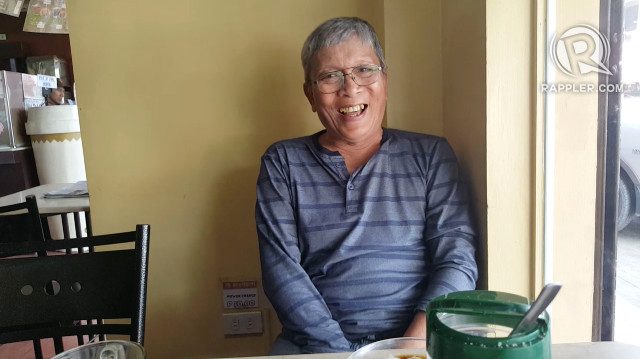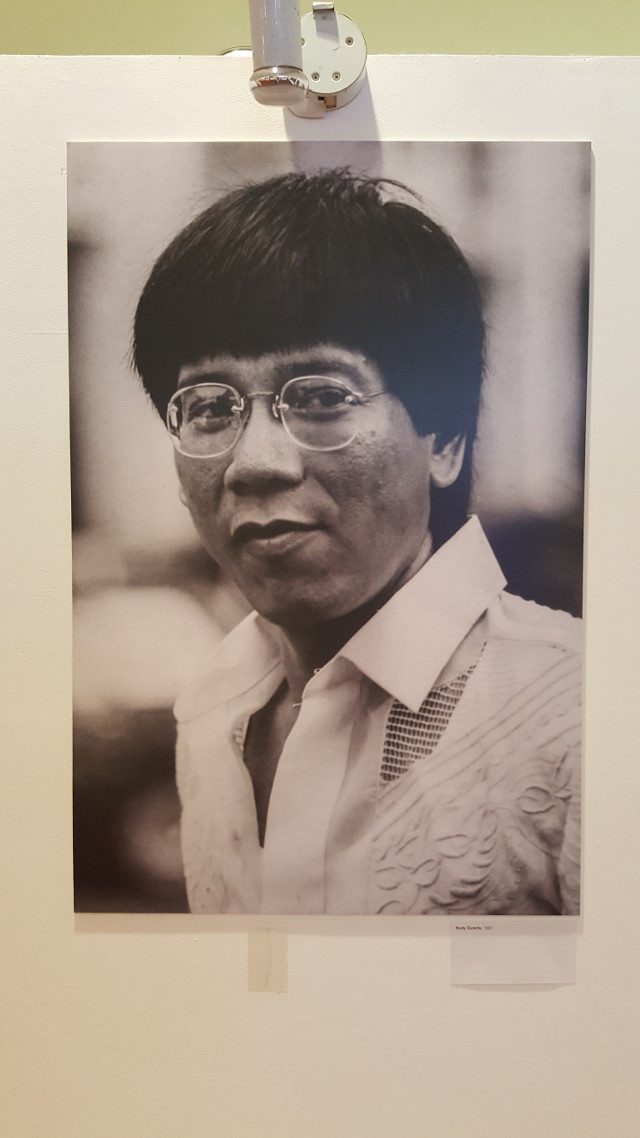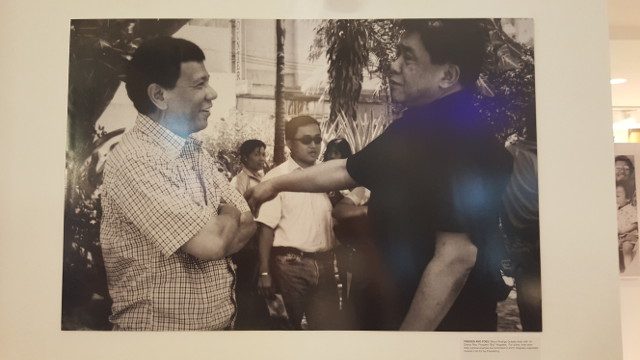SUMMARY
This is AI generated summarization, which may have errors. For context, always refer to the full article.

DAVAO CITY, Philippines – A 42-year-old Rodrigo Duterte casts a sideway glance in a black and white photograph by Rene Lumawag.
He wears round glasses under thick bowl-cut hair. His barong clashes with the expression on his face that seems to say he’s up to no good.
This simple portrait is Lumawag’s favorite out of his exhibit of 30 photographs of Duterte’s political career.
The exhibit, “Rody Duterte: Through the Years,” is open to the public until July 3 at the Ayala Abreeza Mall in Davao City.
The day after its opening, I have breakfast with Lumawag in a cafe near his house. Lumawag, at 71 (he’s only 4 months older than Duterte), is a small man with a big laugh.
He demonstrates this with gusto after he gives the best impression of Duterte I’ve ever seen.
It’s no wonder the man can capture the ticks and mannerisms that make Duterte, Duterte. Lumawag has been covering all 25 years of Duterte’s political career, starting with his first year as officer-in-charge vice mayor of Davao City during the transitional period after the Marcos regime in 1986.
Lumawag took his favorite photo of Duterte the year after. Asked why he likes that photo so much, he says, “There’s an underlying statement, tipong may nagawa o may gagawing kabalastugan na naman (as if he has done or is about to do something outrageous).”
It’s a tribute to a man now famous for his disarming sense of humor, a man who has skirted so many conventions yet has managed to win the trust of 16.6 million people, enough people to elect him to the highest post in the land.
‘Shutterbug’
Lumawag calls himself a latecomer in photography. The first time he held his own camera, a Minolta 100X with a 45 mm fixed lens, was in 1979, a few years after moving his young family to Davao City. He was then a radio show host. His first “teacher” was the camera’s user manual.
At first, he was only using his camera to take photos of his children and beautiful scenery. Then he would bring his camera along to news coverage. His friends in local papers started to ask him if he had photos of those events.
But his big break as a photojournalist came when, in 1985, a landslide struck a gold mine in Diwalwal, Davao del Norte. A Reuters photographer asked him to cover it. Days after, photos with his byline were in the world’s newspapers.
A year after, along came the fall of Ferdinand Marcos and in came a new transitional government for Davao City. That was when Lumawag met Duterte, the new OIC vice mayor, who struck him as just “an ordinary guy.”

Lumawag, as well as other media, tagged along with then OIC Mayor Zafiro Respicio and OIC Vice Mayor Duterte during their rounds in the city.
One photo in the exhibit shows the two officials seated in a hut surrounded by indigenous peoples in the middle of a meeting to settle a tribal war.
Lumawag’s subject had then been Respicio but the coming years would show that it would be Duterte making news. Duterte won as mayor in 1989, beating Respicio.
Lumawag now had to cover Mayor Duterte. Seeing each other on a regular basis, it was inevitable the two would strike a friendship.
After a day of checking on police operations, Lumawag would share a late-night snack with Duterte in the latter’s old home.
“Usually, we would be hungry by the time we dropped him off at his house. So Elizabeth (Duterte’s then-wife) and the maid would cook us something to eat,” said Lumawag.
Lumawag soon became one of the photographers trusted not only by Duterte but by his family. Duterte and his children would even give him a nickname, Shutterbug.
“Shutterbug, may lakad ako mamayang hapon ah (Shutterbug, I’m going out later),” Duterte would say.
Duterte’s ex-wife Elizabeth Zimmerman recalls a time when Lumawag went with their family on a motorcycle trip.
“It started to rain. We were soaking wet but he was still taking photos of us,” she said during the opening of his exhibit.
Duterte trusted Lumawag enough to invite him to his trip in Indonesia and two motorcycle trips around the Philippines in the ’90s.
Lumawag describes Duterte as having a “well-rounded personality.”
He was a fearsome disciplinarian to the oppressive – like drivers who parked in the wrong place or policemen who withheld their salary from their wives.
But he was generous to his friends and Davaoeños who needed his help.
Lumawag recalls fwhen Duterte was dropping off relief goods by helicopter following a typhoon.
They delivered food packs to barangays, the police outpost, the army outpost, and the New People’s Army outpost.
Duterte was asked, “Why did you give to the NPA?”
He had replied, “Mayor din ako nila.” (I am also their mayor.)
Then there were the long lines of people outside Duterte’s office every day waiting for a chance to speak with him.
He would entertain everyone “until the last man standing,” ending the session past midnight, said Lumawag.
He loved to photograph Duterte during visits to hospitals.
“I could see the compassion. He would talk to them, whether kids or the old. He would have cartons and cartons of toys for the kids,” shared Lumawag.
With Duterte about to take his place in Malacañang, some have asked Lumawag if he would want to be photography director for the new president.
But Lumawag is not so crazy about the offer, saying his place is in Davao City.
Sacrifices
His years as a photojournalist have enriched his life with memories, but he, more than anyone, should know about the sacrifices that men and women in the media make.
“To be a dedicated photojournalist, life will not be easy in the field and at home. Siyempre, buwis buhay ka (you risk your life), you don’t know what’s going to happen. Magkano suweldo mo? (How much is your salary?)” Lumawag said.
It was even worse in the days of film photography when he was forced to spend some of his hard-earned money on film and developing his rolls.
“Napatapos ko ‘yung mga anak ko pero talagang ginapang ko lang,” he said. (I was able to put my kids through school but I really had a hard time.)

Then in 2004, Lumawag’s son Gene Boyd, who followed in his footsteps as a photographer, was shot dead in Jolo, Sulu while on assignment.
Gene Boyd had gone to the wharf to take a photo of the sunset. He was walking back to his hotel when he was shot in the back. To this day, Lumawag does not know who killed his son.
“We have his last frame, the last sunset,” he said.
Lumawag’s face brightens when he talks about his 4 surviving children and his wife Minerva who is now on an “apostolic mission” to take care of their apo or grandchildren in the United States.
Lumawag, like Duterte, is still a working septuagenarian. You will still find him on the sidelines of Davao City events, which have become national events too, facing his bulky camera to the scene he wants to immortalize.
Despite all the hardships, photography has its rewards, he said.
“You will learn to love details. You will learn to love the unexpected beauty of nature. You will come to know the different personalities, inner traits,” he said.
To future photographers of Duterte, Lumawag has this for advice: “Anticipate your frame and anticipate his mood.”
Dedicated photographers should hone their skills every day, even when there is nothing important to cover.
“Every day is a learning day. Ako, usually ‘pag dalawang araw hindi ako makapitik dahil nasa bahay lang ako, on the third day kahit man lang ‘yung ordinaryong bulaklak makakuha ako ng magandang litrato,” he said.
(Me, usually when I’m not able to press a shutter for two days in a row because I’m just in the house, on the third day, I try to take a beautiful photo even of just an ordinary flower.)
Lumawag follows his own advice. Before meeting me for breakfast, he had gone to a nearby beach to take photographs of children jumping into the water.
And as we sip coffee, he suddenly, exclaims, “Ganda ng photo! (What a nice photo!)” and points to a man carrying dozens of plastic bags full of kapok, a fiber used as pillow stuffing.
“Hindi ko man sinasadya, hinihila lang ako (I don’t intend for it to happen, I am just pulled toward it),” he said.
Lumawag’s heeding the call of the photograph has benefited not only newspapers but the city of Davao as well.
In his photos, they have a treasure trove of memories to remind them of the story they share with the man who, in a few days, will cease to be their mayor and will start his work as the country’s president.
This is Lumawag’s unique gift to Duterte’s city. – Rappler.com
Add a comment
How does this make you feel?
There are no comments yet. Add your comment to start the conversation.